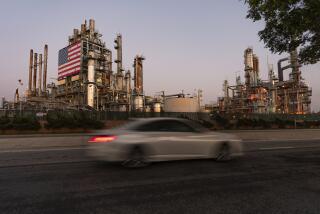Several Factors Boosting Gas Prices
With gasoline prices in California once again on the rise, industry experts are blaming an assortment of factors, including high crude oil prices, market speculation and preparations for the state’s switch to summertime fuel.
The average price of self-serve regular gasoline in Los Angeles County jumped 3.4 cents this week to $1.812 a gallon, the Automobile Club of Southern California said Friday. The group’s weekly survey found that San Diego prices rose 4 cents to $1.836 a gallon.
Since the beginning of the year, gas prices have leaped 18.6 cents a gallon in the Los Angeles region and 18 cents a gallon in San Diego, the Auto Club said. The nationwide average rose less than half a cent to $1.627 in the last week, and is up 14.3 cents so far this year.
Most experts point to the high price of crude oil as the primary factor behind the steady increase. Crude oil is the base ingredient in gasoline, and the cost per barrel of oil has been unusually high -- above $30 a barrel -- for most of the last four months.
On Friday, crude closed at $32.48 a barrel, down 60 cents, on the New York Mercantile Exchange. Traders are watching for signs that ministers of the Organization of the Petroleum Exporting Countries, who are to meet Tuesday, will raise or lower production or leave worldwide supplies as they are.
“I think OPEC will meet and go home and do nothing,” said Philip K. Verleger Jr., an energy analyst with the Council on Foreign Relations in New York. “Inventories are low, which is their goal, to keep stocks tight. They really don’t have an excuse to cut production.”
In California, however, there also are other factors at work.
January and February, traditionally low-demand months for gasoline, are chock full of “turnarounds,” or annual maintenance projects, that reduce output at the state’s fuel-producing refineries. In addition, refineries are loath to stock up on extra gasoline in February because they must start selling a different formula March 1.
Under state emission rules, refiners must change the gasoline recipe in the warmer months to keep the fuel within pollution limits by offsetting its tendency to evaporate at higher temperatures. In California, summertime gasoline is sold to consumers for eight months of the year.
“We’ve got people out in turnarounds. We’ve got one refiner that’s got an unexpected problem, which causes speculation on the price even if there isn’t an impact on the market,” said Claudia Chandler, assistant executive director at the California Energy Commission. “It’s all of the above” as well as crude oil prices, Chandler said of the latest gasoline price runup.
However, Auto Club spokesman Jeff Spring said such factors don’t fully explain the rapid price increase.
Last year at this time, the California gasoline market faced similar conditions in addition to some events not present today, including a damaging oil worker strike in Venezuela and market jitters over a possible war in Iraq. Spring sees market speculation in the mix.
“We’re already higher than we were last year,” he said. “I don’t see a real solid explanation this time.”
Whatever the reasons, California motorists seem fated again this year to pay higher prices during the spring and summer driving seasons.
As the energy commission’s Chandler noted, gasoline supplies are so tightly balanced with demand in California that “any little gyration drives the price up.”
More to Read
Inside the business of entertainment
The Wide Shot brings you news, analysis and insights on everything from streaming wars to production — and what it all means for the future.
You may occasionally receive promotional content from the Los Angeles Times.










